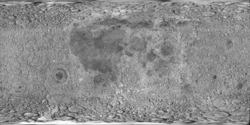Aitken (månkrater)
| Månkrater | ||
|---|---|---|
| Aitken | ||
 Scheele fotograferad av Apollo 16 | ||
| Egenskaper | ||
| Latitud Longitud | ||
| Medeldiameter | 129.69 km | |
| Djup | 6 km | |
| Kolongitud | 187° vid soluppgång | |
| Eponym | Robert Grant Aitken | |
| Kartposition | ||
| Månen - Selenografi - ( ) | ||
Aitken är en stor nedslagskrater på månens bortre sida (som aldrig är vänd mot Jorden). Den är lokaliserad till sydväst om kratern Heaviside och norr om den ovanliga kraterformationen Van de Graaff. Kratern Vertregt är förbunden med Aitkens sydvästra kraterrand. Till sydöst ligger den mindre kratern Bergstrand
De inre kraterväggarna i Aitken är terrassformade och varierar tydligt i bred, med den tunnaste delen i sydväst. Kratern Aitken Z ligger längs med den inre norra kraterväggen. Strax norr om kraterranden ligger den lilla kratern Aitken A, som är omgiven av en utslungad täcke av material med ljus albedo. Det inre golvet har tidigare fått en ny yta av lavaflöden som gett den en mörkare albedo, särskilt den södra halvan av kratern. Det är även ett flertal mindre nedslagskratrar på det östra delen av kratergolvet.
Denna krater ligger längs med den norra kraterranden av den enorma Sydpol-Aitken bassängen. Denna döptes efter denna krater och månens sydpol, de två yttersta punkterna i formationen.
Satellitkratrar
På månkartor är dessa objekt genom konvention identifierade genom att placera ut bokstaven på den sida av kraterns mittpunkt som är närmast kratern Aitken.
| Aitken | Latitud | Longitud | Diameter |
|---|---|---|---|
| A | 14.0° S | 173.7° Ö | 13 km |
| C | 14.0° S | 175.8° Ö | 74 km |
| G | 16.8° S | 174.2° Ö | 7 km |
| N | 17.7° S | 172.7° Ö | 7 km |
| Y | 12.0° S | 173.2° Ö | 35 km |
| Z | 15.1° S | 173.3° Ö | 33 km |
Se även
Källor
- Artikeln är, helt eller delvis, en översättning från engelskspråkiga Wikipedia.
- ”Aitken on Moon” (på engelska). International Astronomical Union. 18 oktober 2010. https://planetarynames.wr.usgs.gov/Feature/119. Läst 30 maj 2024.
Media som används på denna webbplats
Red dot, based on the image on en:.
cylindrical map projection of the Moon. The Moon's whole surface was mapped by the Clementine spacecraft in 1994, here North is at the top. The dark floor of crater Plato is at the middle top above Mare Imbrium, while the bright floor and rays of crater Tycho is near the middle bottom below Mare Imbrium. Mare Procellarum is at the near left, and Mare Tranquillitatis is just right of centre and Mare Crisium is at the near right. The far left and far right show the contrast of the mostly cratered farside with small isolated mare.
(c) Gregory H. Revera, CC BY-SA 3.0
Full Moon photograph taken 10-22-2010 from Madison, Alabama, USA. Photographed with a Celestron 9.25 Schmidt-Cassegrain telescope. Acquired with a Canon EOS Rebel T1i (EOS 500D), 20 images stacked to reduce noise. 200 ISO 1/640 sec.
Caption of original upload:
- View of Aitken crater on the Moon from Apollo 17. This image was created Apollo 17 mapping metric sequence, revolution #14. The Hi-res image was reduced to 25% of normal size, then rotated 90° counter-clockwise so that north is up. It is at selenographic coordinates 16.30° S, 172.90° E.
This photo was used in Figure 178 of Apollo Over the Moon: A View from Orbit (NASA SP-362, 1978), which has the following caption:
- Aitken is a large crater (145 km in diameter) on the far side. Like many other large, young craters it has an outer field of secondary crater clusters and chains, an extensive inner blanket of bright ejecta, bright and rugged walls, a flat floor partly occupied by dark mare material, and a central peak complex. However, in several respects Aitken differs from other craters of comparable age and size. Its central peak has an unusual subcircular pattern, its rim crest is complexly crenulated, and its walls are best described as jumbled (El-Baz, 1973a) rather than terraced. The last two characteristics may have been caused by the shock associated with the formation of the large crater (30-km-diameter) on Aitken's north wall. The shock may well have destroyed the preexisting terraces and caused the additional slumping that gives the rim crest its crenulated appearance. Many interesting features are visible on Aitken's floor. Among them are some unusual ridges (arrow), which were described earlier (fig. 84), and several very unusual craters or depressions, some of which may be the sources of the mare fill (El-Baz, 1973a).-G.W.C.
Photographic data:
- Image Name: AS17-M-0341
- Mission: Apollo 17
- Revolution (Orbit): 14
- Camera: Mapping/Metric
- Exposure: 00:00:00.009
- Camera Tilt: VERT
- Sun Elevation: 22.0°
- Features: AITKEN
- Film Type: 3400
- Color: black&white





